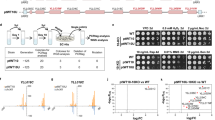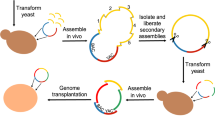Abstract
Recent advances in DNA synthesis technology have enabled the construction of novel genetic pathways and genomic elements, furthering our understanding of system-level phenomena1,2,3,4,5,6,7. The ability to synthesize large segments of DNA allows the engineering of pathways and genomes according to arbitrary sets of design principles. Here we describe a synthetic yeast genome project, Sc2.0, and the first partially synthetic eukaryotic chromosomes, Saccharomyces cerevisiae chromosome synIXR, and semi-synVIL. We defined three design principles for a synthetic genome as follows: first, it should result in a (near) wild-type phenotype and fitness; second, it should lack destabilizing elements such as tRNA genes or transposons8,9; and third, it should have genetic flexibility to facilitate future studies. The synthetic genome features several systemic modifications complying with the design principles, including an inducible evolution system, SCRaMbLE (synthetic chromosome rearrangement and modification by loxP-mediated evolution). We show the utility of SCRaMbLE as a novel method of combinatorial mutagenesis, capable of generating complex genotypes and a broad variety of phenotypes. When complete, the fully synthetic genome will allow massive restructuring of the yeast genome, and may open the door to a new type of combinatorial genetics based entirely on variations in gene content and copy number.
This is a preview of subscription content, access via your institution
Access options
Subscribe to this journal
Receive 51 print issues and online access
$199.00 per year
only $3.90 per issue
Buy this article
- Purchase on Springer Link
- Instant access to full article PDF
Prices may be subject to local taxes which are calculated during checkout




Similar content being viewed by others
Accession codes
References
Han, J. S. & Boeke, J. D. A highly active synthetic mammalian retrotransposon. Nature 429, 314–318 (2004)
Richardson, S. M., Wheelan, S. J., Yarrington, R. M. & Boeke, J. D. GeneDesign: rapid, automated design of multikilobase synthetic genes. Genome Res. 16, 550–556 (2006)
Chan, L. Y., Kosuri, S. & Endy, D. Refactoring bacteriophage T7. Mol. Syst. Biol. 1, 2005.0018 (2005)
Stricker, J. et al. A fast, robust and tunable synthetic gene oscillator. Nature 456, 516–519 (2008)
Gibson, D. G. et al. One-step assembly in yeast of 25 overlapping DNA fragments to form a complete synthetic Mycoplasma genitalium genome. Proc. Natl Acad. Sci. USA 105, 20404–20409 (2008)
Gibson, D. G. et al. Creation of a bacterial cell controlled by a chemically synthesized genome. Science 329, 52–56 (2010)
Lartigue, C. et al. Creating bacterial strains from genomes that have been cloned and engineered in yeast. Science 325, 1693–1696 (2009)
Ji, H. et al. Hotspots for unselected Ty1 transposition events on yeast chromosome III are near tRNA genes and LTR sequences. Cell 73, 1007–1018 (1993)
Admire, A. et al. Cycles of chromosome instability are associated with a fragile site and are increased by defects in DNA replication and checkpoint controls in yeast. Genes Dev. 20, 159–173 (2006)
Churcher, C. et al. The nucleotide sequence of Saccharomyces cerevisiae chromosome IX. Nature 387, 84–87 (1997)
Park, H. et al. Expanding the genetic code of Escherichia coli with phosphoserine. Science 333, 1151–1154 (2011)
Isaacs, F. J. et al. Precise manipulation of chromosomes in vivo enables genome-wide codon replacement. Science 333, 348–353 (2011)
Hoess, R. H., Wierzbicki, A. & Abremski, K. The role of the loxP spacer region in P1 site-specific recombination. Nucleic Acids Res. 14, 2287–2300 (1986)
Vollrath, D., Davis, R. W., Connelly, C. & Hieter, P. Physical mapping of large DNA by chromosome fragmentation. Proc. Natl Acad. Sci. USA 85, 6027–6031 (1988)
Lindstrom, D. L. & Gottschling, D. E. The mother enrichment program: a genetic system for facile replicative life span analysis in Saccharomyces cerevisiae. Genetics 183, 413–422 (2009)
Kuras, L., Cherest, H., Surdin-Kerjan, Y. & Thomas, D. A heteromeric complex containing the centromere binding factor 1 and two basic leucine zipper factors, Met4 and Met28, mediates the transcription activation of yeast sulfur metabolism. EMBO J. 15, 2519–2529 (1996)
Ogawa, H. & Fujioka, M. Purification and characterization of saccharopine dehydrogenase from baker’s yeast. J. Biol. Chem. 253, 3666–3670 (1978)
Sambrook, J. & Russell, D. W. Isolation of BAC DNA from small-scale cultures. Cold Spring Harb. Protoc. 10.1101/pdb.prot4006 (2006)
Hoffman, C. S. Preparation of yeast DNA. Curr. Protoc. Mol. Biol. Ch. 13, Unit 13.11. (2001)
Boeke, J. D., Garfinkel, D. J., Styles, C. A. & Fink, G. R. Ty elements transpose through an RNA intermediate. Cell 40, 491–500 (1985)
Schwartz, D. C. & Cantor, C. R. Separation of yeast chromosome-sized DNAs by pulsed field gradient gel electrophoresis. Cell 37, 67–75 (1984)
Lemoine, F. J., Degtyareva, N. P., Lobachev, K. & Petes, T. D. Chromosomal translocations in yeast induced by low levels of DNA polymerase: a model for chromosome fragile sites. Cell 120, 587–598 (2005)
Louis, E. J. The chromosome ends of Saccharomyces cerevisiae. Yeast 11, 1553–1573 (1995)
Parenteau, J. et al. Deletion of many yeast introns reveals a minority of genes that require splicing for function. Mol. Biol. Cell 19, 1932–1941 (2008)
Percudani, R., Pavesi, A. & Ottonello, S. Transfer RNA gene redundancy and translational selection in Saccharomyces cerevisiae. J. Mol. Biol. 268, 322–330 (1997)
Dymond, J. S. et al. Teaching synthetic biology, bioinformatics and engineering to undergraduates: the interdisciplinary build-a-genome course. Genetics 181, 13–21 (2009)
Hampsey, M. A review of phenotypes in Saccharomyces cerevisiae. Yeast 13, 1099–1133 (1997)
Abramoff, M. D., Magelhaes, P. J. & Ram, S. J. Image processing with ImageJ. Biophotonics Int. 11, 36–42 (2004)
Blake, W. J. et al. Pairwise selection assembly for sequence-independent construction of long-length DNA. Nucleic Acids Res. 38, 2594–2602 (2010)
Acknowledgements
We thank G. Church for suggesting the global substitution of TAG codons with TAA codons, C. Connelly for sharing technical expertise and V. Huang for generating a sequence visualizer. We are grateful to B. Cormack, G. Seydoux and J. Nathans for offering helpful advice, to Y. Cai and J. Peccoud for suggesting methods to validate the sequence data, and to E. Louis for providing expert advice on telomeres. The work was supported by National Science Foundation grant MCB0718846 to J.D.B., J.S.B. and S.C.; by a grant from Microsoft to J.S.B. and J.D.B.; by Department of Energy Fellowship DE-FG02097ER25308 to S.M.R.; by National Institutes of Health grant AG023779 to D.E.G.; and by a fellowship from Fondation pour la Recherche Médicale to H.M.
Author information
Authors and Affiliations
Contributions
J.S.D., S.M.R., S.C., J.S.B. and J.D.B. designed experiments. J.S.D., S.M.R., C.E.C., T.B., H.M., N.A., J.W.S., J.D. and A.C.B. performed experiments. W.J.B. built the synIXR chromosome. D.L.L. and D.E.G. generated the integrated CRE-EBD cassette. J.S.D., S.M.R., J.S.B. and J.D.B. analysed data and wrote the manuscript.
Corresponding author
Ethics declarations
Competing interests
The authors declare no competing financial interests.
Supplementary information
Supplementary Information
This file contains Supplementary Text 1-8, Supplementary References and Supplementary Figures 1-13 with legends. (PDF 1729 kb)
Supplementary Tables
This file contains Supplementary Tables 1-8. This file was corrected on 22 September 2011 due to an error in one of the tables. (PDF 908 kb)
Rights and permissions
About this article
Cite this article
Dymond, J., Richardson, S., Coombes, C. et al. Synthetic chromosome arms function in yeast and generate phenotypic diversity by design. Nature 477, 471–476 (2011). https://doi.org/10.1038/nature10403
Received:
Accepted:
Published:
Issue Date:
DOI: https://doi.org/10.1038/nature10403
This article is cited by
-
A designer synthetic chromosome fragment functions in moss
Nature Plants (2024)
-
A robust yeast biocontainment system with two-layered regulation switch dependent on unnatural amino acid
Nature Communications (2023)
-
Trimming the genomic fat: minimising and re-functionalising genomes using synthetic biology
Nature Communications (2023)
-
Engineering the gut microbiome
Nature Reviews Bioengineering (2023)
-
A framework to efficiently describe and share reproducible DNA materials and construction protocols
Nature Communications (2022)
Comments
By submitting a comment you agree to abide by our Terms and Community Guidelines. If you find something abusive or that does not comply with our terms or guidelines please flag it as inappropriate.



